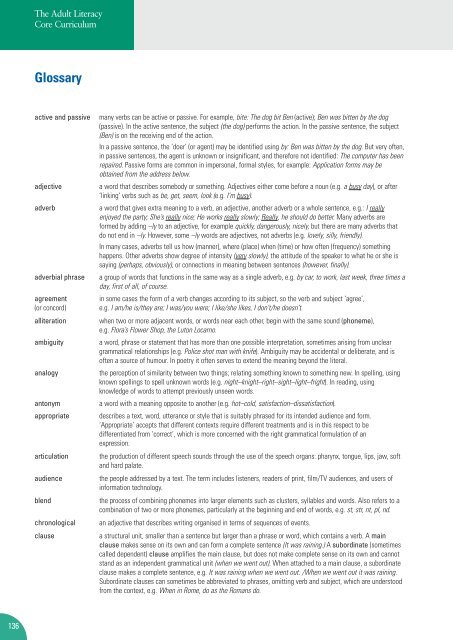Adult Literacy Core Curriculum - Nationally developed Skills for Life ...
Adult Literacy Core Curriculum - Nationally developed Skills for Life ...
Adult Literacy Core Curriculum - Nationally developed Skills for Life ...
You also want an ePaper? Increase the reach of your titles
YUMPU automatically turns print PDFs into web optimized ePapers that Google loves.
136<br />
The <strong>Adult</strong> <strong>Literacy</strong><br />
<strong>Core</strong> <strong>Curriculum</strong><br />
Glossary<br />
active and passive many verbs can be active or passive. For example, bite: The dog bit Ben (active); Ben was bitten by the dog<br />
(passive). In the active sentence, the subject (the dog) per<strong>for</strong>ms the action. In the passive sentence, the subject<br />
(Ben) is on the receiving end of the action.<br />
In a passive sentence, the ‘doer’ (or agent) may be identified using by: Ben was bitten by the dog. But very often,<br />
in passive sentences, the agent is unknown or insignificant, and there<strong>for</strong>e not identified: The computer has been<br />
repaired. Passive <strong>for</strong>ms are common in impersonal, <strong>for</strong>mal styles, <strong>for</strong> example: Application <strong>for</strong>ms may be<br />
obtained from the address below.<br />
adjective a word that describes somebody or something. Adjectives either come be<strong>for</strong>e a noun (e.g. a busy day), or after<br />
‘linking’ verbs such as be, get, seem, look (e.g. I’m busy).<br />
adverb a word that gives extra meaning to a verb, an adjective, another adverb or a whole sentence, e.g.: I really<br />
enjoyed the party; She’s really nice; He works really slowly; Really, he should do better. Many adverbs are<br />
<strong>for</strong>med by adding –ly to an adjective, <strong>for</strong> example quickly, dangerously, nicely, but there are many adverbs that<br />
do not end in –ly. However, some –ly words are adjectives, not adverbs (e.g. lovely, silly, friendly).<br />
In many cases, adverbs tell us how (manner), where (place) when (time) or how often (frequency) something<br />
happens. Other adverbs show degree of intensity (very slowly), the attitude of the speaker to what he or she is<br />
saying (perhaps, obviously), or connections in meaning between sentences (however, finally).<br />
adverbial phrase a group of words that functions in the same way as a single adverb, e.g. by car, to work, last week, three times a<br />
day, first of all, of course.<br />
agreement in some cases the <strong>for</strong>m of a verb changes according to its subject, so the verb and subject ‘agree’,<br />
(or concord) e.g. I am/he is/they are; I was/you were; I like/she likes, I don’t/he doesn’t.<br />
alliteration when two or more adjacent words, or words near each other, begin with the same sound (phoneme),<br />
e.g. Flora’s Flower Shop, the Luton Locarno.<br />
ambiguity a word, phrase or statement that has more than one possible interpretation, sometimes arising from unclear<br />
grammatical relationships (e.g. Police shot man with knife). Ambiguity may be accidental or deliberate, and is<br />
often a source of humour. In poetry it often serves to extend the meaning beyond the literal.<br />
analogy the perception of similarity between two things; relating something known to something new. In spelling, using<br />
known spellings to spell unknown words (e.g. night–knight–right–sight–light–fright). In reading, using<br />
knowledge of words to attempt previously unseen words.<br />
antonym a word with a meaning opposite to another (e.g. hot–cold, satisfaction–dissatisfaction).<br />
appropriate describes a text, word, utterance or style that is suitably phrased <strong>for</strong> its intended audience and <strong>for</strong>m.<br />
‘Appropriate’ accepts that different contexts require different treatments and is in this respect to be<br />
differentiated from ‘correct’, which is more concerned with the right grammatical <strong>for</strong>mulation of an<br />
expression.<br />
articulation the production of different speech sounds through the use of the speech organs: pharynx, tongue, lips, jaw, soft<br />
and hard palate.<br />
audience the people addressed by a text. The term includes listeners, readers of print, film/TV audiences, and users of<br />
in<strong>for</strong>mation technology.<br />
blend the process of combining phonemes into larger elements such as clusters, syllables and words. Also refers to a<br />
combination of two or more phonemes, particularly at the beginning and end of words, e.g. st, str, nt, pl, nd.<br />
chronological an adjective that describes writing organised in terms of sequences of events.<br />
clause a structural unit, smaller than a sentence but larger than a phrase or word, which contains a verb. A main<br />
clause makes sense on its own and can <strong>for</strong>m a complete sentence (It was raining.) A subordinate (sometimes<br />
called dependent) clause amplifies the main clause, but does not make complete sense on its own and cannot<br />
stand as an independent grammatical unit (when we went out). When attached to a main clause, a subordinate<br />
clause makes a complete sentence, e.g. It was raining when we went out. /When we went out it was raining.<br />
Subordinate clauses can sometimes be abbreviated to phrases, omitting verb and subject, which are understood<br />
from the context, e.g. When in Rome, do as the Romans do.

















